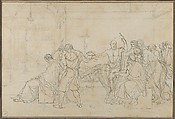The Death of Socrates
Jacques Louis David French
Not on view
This sheet is a study for Jacques Louis David’s 1787 painting, The Death of Socrates 31.45, which entered the Met’s collection in 1931. The subject of the Greek philosopher’s death in prison was first explored by David in 1782, but he returned to it with renewed purpose when Charles Louis Trudaine de Montigny, a wealthy conseiller in the Paris parliament, commissioned from him a painting on the theme in 1786. The four intervening years had been critical ones in terms of David’s artistic formation and the development of Neoclassicism, marked by such groundbreaking canvases as Andromache Mourning Hector (1783) and The Oath of the Horatii (1785), and he was clearly brimming over with new ideas and insights into the treatment of the subject, ideas which he put down here with great speed and urgency.
Taking his 1782 composition 2013.59 as a starting point, David quickly put to paper an elaborated and revised version of the composition. The disciple who hands Socrates the cup of hemlock is in a pose of greater tension and has been moved to the left, opening up space in the middle of the scene to isolate and emphasize the charged vignette of the poison passing from one hand to another. The disciples on the right have expanded in number from four to six, and Crito, seated on the stone block in the foreground, no longer holds a book, but instead grasps Socrates’s thigh, as if beseeching him to change his mind. The sketchy architectural indications on the left contain evidence of the artist's evolving ideas on the form of a receding hallway ending in a set of stairs, by which Socrates’s family takes their leave. In the 1782 version, the figures had been set against a flat stone backdrop, suggesting the unrelieved severity of his prison cell.
As a working drawing, the sheet sheds light on the artist’s main concerns. The perspective lines at lower left recede toward a vanishing point just above the head of Plato, the somber figure seated at the foot of the bed. In this subtle way, David calls attention to the special role of Plato, who was not present in Socrates’ prison cell, but who described the scene in Phaedo, one of his Dialogues. As Socrates’s gesture toward the heavens suggests, his final moments were spent in describing to his disciples his notions on the immortality of the soul. Just behind Socrates’s right leg David has lightly sketched the form of an ancient lyre, a musical instrument that figures—metaphorically—in Plato’s text as a proposed analogy for the relationship of the human soul (music) to the body (instrument). The many visible pentimenti, or changes, in the disciple’s hand holding the cup, in Socrates’s hand pointing up, and in both of Socrates’s legs, are all indications of the artist’s exacting focus of the nexus of forms and gestures that would become the resonant and haunting focal point of the painting.
(Perrin Stein, July 2017)
Due to rights restrictions, this image cannot be enlarged, viewed at full screen, or downloaded.






